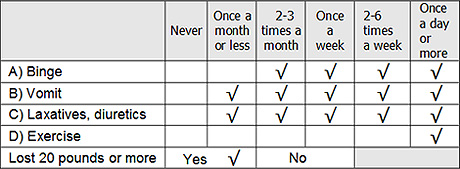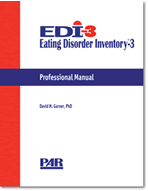Anonymous Feedback
Use the EAT-26 to help you determine if you need to speak to a mental health professional to get help for an eating disorder. It will take about 2 minutes to complete.
Take the EAT-40. The EAT-40 is the original version of the Eating Attitudes Test. The 40-item version was shortened to 26-items (EAT-26) based on a factor analysis.
SCORING
Referral Criteria A, B and C
EAT-26 Test Score:
Test Items and Total Test Score:
- Items 1-25 are scored as follows: Always = 3; Usually = 2; Often = 1; Other answers = 0
- Item 26 is scored in the opposite direction (Never = 3 etc.)
- Total Test Score: Add item scores for a “total test score.”
-
Is the total 20 or more? No__ Yes__, make a referral
Behavioral Questions:
- Did the respondent check any of the boxes as shown below? No__ Yes__, make a referral

Underweight:
Determine Body Mass Index (BMI) to determine if the respondent is underweight.
Divide weight in pounds by height in inches and then by height in inches again and then multiply by 703
Example: 5’4” = 64 inches. Weight = 105 lbs. So, (105 ÷ 64=1.641) (1.64 ÷ 64=.0256) (X 703= 18.0)
Below are the BMI thresholds for defining if the respondent is underweight by age and sex.
![]()
Is the total 20 or more? No__ Yes__, make a referral
What to do about Missing Data:
There is no agreed-upon procedure for dealing with missing data for the EAT-26. However, it is recommended that interpolation be used to estimate up to one missing value for each EAT-26 subscale using the median subscale item value (rounding up to a whole number) to construct the missing data point. This seems to achieve a fair balance between including questionnaires in which a small number of values may have been inadvertently omitted, while at the same time maintaining data integrity by excluding questionnaires with more missing data.


